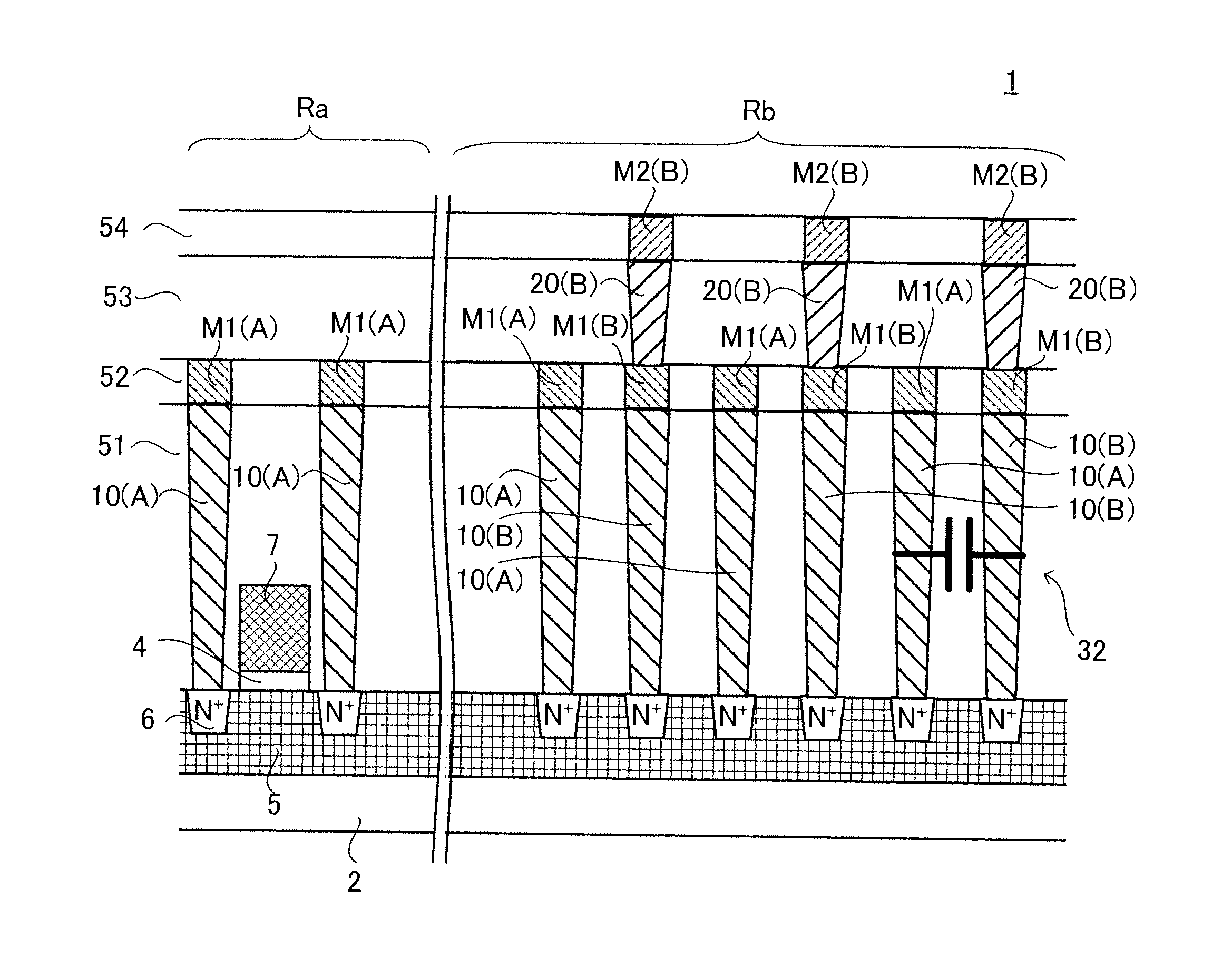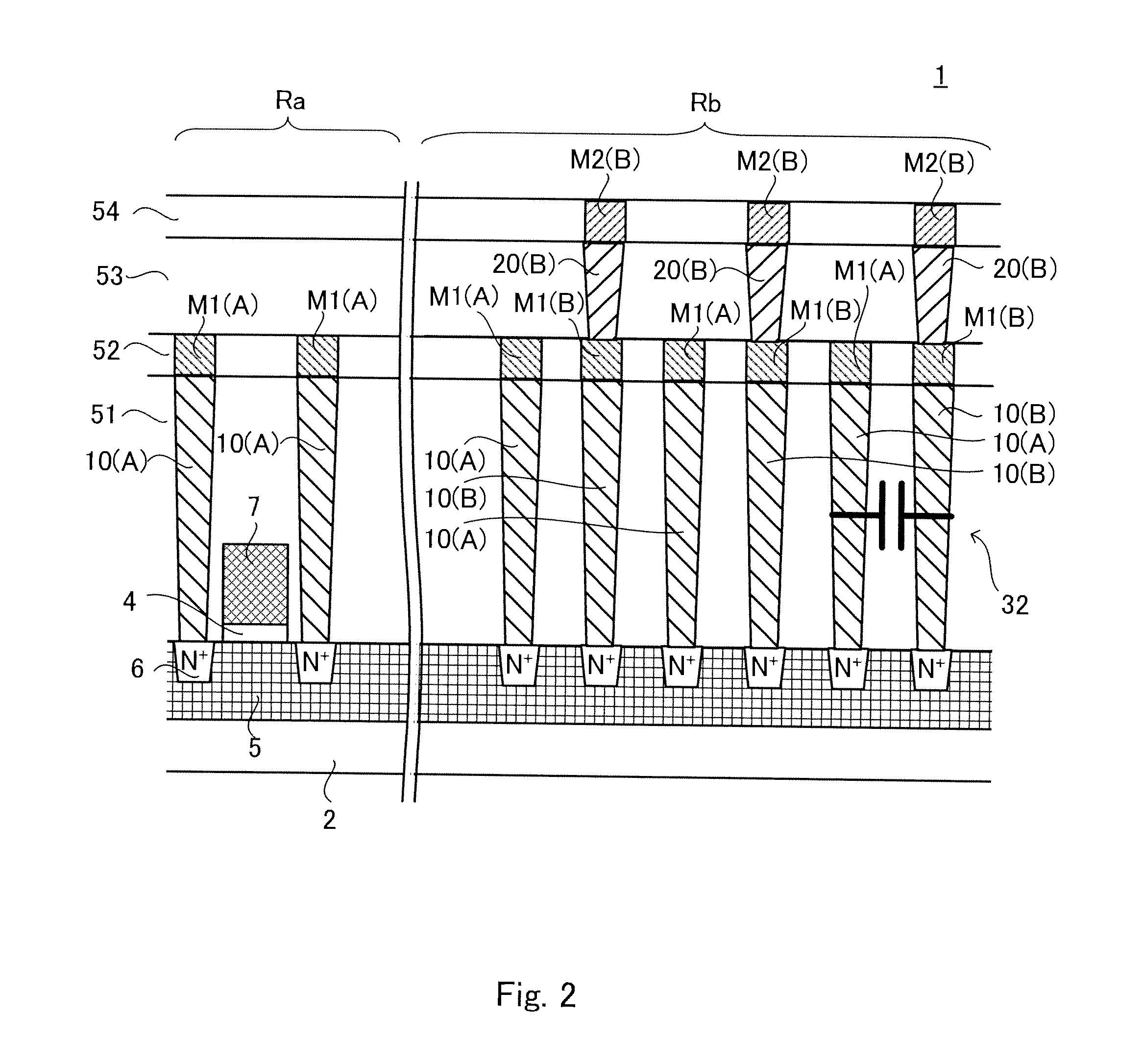Semiconductor device
- Summary
- Abstract
- Description
- Claims
- Application Information
AI Technical Summary
Benefits of technology
Problems solved by technology
Method used
Image
Examples
first exemplary embodiment
[0041]FIG. 1 is a schematic plane view of a semiconductor device according to a first exemplary embodiment of the present invention. FIG. 2 is a sectional view taken along the line II-II of FIG. 1. In FIG. 1, the positions of contact plugs are indicated by dotted lines for convenience of the explanation thereof.
[0042]A semiconductor device 1 includes a semiconductor substrate 2, active regions 6, a gate insulating film 4, a gate electrode layer 7, side walls (not shown), first layer wirings M1 and second layer wirings M2 functioning as layer wirings, contact plugs to be described later, a first interlayer dielectric 51, a second interlayer dielectric 52, a third interlayer dielectric 53, and a fourth interlayer dielectric 54.
[0043]Note that the term “layer wiring” herein described refers to an electrically conductive layer of the bottom layer in the wirings that are connected at an upper part of the contact plug, and to electrically conductive layers formed above the bottom layer in...
second exemplary embodiment
[0069]Next, a description is given of an example of a semiconductor device which is different from the above-mentioned exemplary embodiment. FIG. 5 shows a schematic sectional view of a semiconductor device 1a according to a second exemplary embodiment of the present invention. The semiconductor device 1a has the logic section Ra, the capacitative element section Rb, and a DRAM (Dynamic Random Access Memory) section Rc. As described earlier, the parasitic capacity between the wirings has been increasing along with the recent advancement in miniaturization of semiconductor devices. Therefore, the parasitic capacity between the contact plugs formed by an advanced process becomes not negligible. Particularly, in the case of a configuration in which contact plugs have a large height, such as a mixed DRAM of a stack type, the influence of the parasitic capacity has become more remarkable. The semiconductor device according to the second exemplary embodiment positively uses the parasitic ...
third exemplary embodiment
[0081]Next, a description is given of an example of a semiconductor device which is different from the first exemplary embodiment. The basic configuration of a semiconductor device 1b according to a third exemplary embodiment of the present invention is similar to that of the first exemplary embodiment, except for the following. That is, in the first exemplary embodiment, the first electrode plugs 10(A) and the second electrode plugs 10(B) have a configuration in which layer wirings (the first layer wirings M1, the second layer wirings M2) and the active regions 6 are connected to each other. Meanwhile, in the third exemplary embodiment, the first electrode plugs and second electrode plugs are disposed between an element isolation region 3 and layer wirings (the first layer wirings M1, the second layer wirings M2).
[0082]FIG. 6 shows a schematic sectional view of the semiconductor device according to the third exemplary embodiment of the present invention. As shown in FIG. 6, first e...
PUM
 Login to View More
Login to View More Abstract
Description
Claims
Application Information
 Login to View More
Login to View More - R&D
- Intellectual Property
- Life Sciences
- Materials
- Tech Scout
- Unparalleled Data Quality
- Higher Quality Content
- 60% Fewer Hallucinations
Browse by: Latest US Patents, China's latest patents, Technical Efficacy Thesaurus, Application Domain, Technology Topic, Popular Technical Reports.
© 2025 PatSnap. All rights reserved.Legal|Privacy policy|Modern Slavery Act Transparency Statement|Sitemap|About US| Contact US: help@patsnap.com



